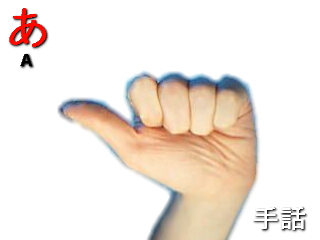|
Japanese Manual Syllabary
The is a system of manual ''kana'' used as part of Japanese Sign Language (JSL). It is a signary of 45 signs and 4 diacritics representing the phonetic syllables of the Japanese language. Signs are distinguished both in the direction they point, and in whether the palm faces the viewer or the signer. For example, the manual syllables ''na, ni, ha'' are all made with the first two fingers of the hand extended straight, but for ''na'' the fingers point down, for ''ni'' across the body, and for ''ha'' toward the viewer. The signs for ''te'' and ''ho'' are both an open flat hand, but in ''te'' the palm faces the viewer, and in ''ho'' it faces away. Although a syllabary rather than an alphabet, manual kana is based on the manual alphabet of American Sign Language. The simple vowels ''a, i, u, e, o'' are nearly identical to the ASL vowels, while the ASL consonants ''k, s, t, n, h, m, y, r, w'' are used for the corresponding syllables ending in the vowel ''a'' in manual kana: ''ka, sa, ... [...More Info...] [...Related Items...] OR: [Wikipedia] [Google] [Baidu] |
Syllabary
In the linguistic study of written languages, a syllabary is a set of written symbols that represent the syllables or (more frequently) moras which make up words. A symbol in a syllabary, called a syllabogram, typically represents an (optional) consonant sound (simple onset) followed by a vowel sound (nucleus)—that is, a CV or V syllable—but other phonographic mappings, such as CVC, CV- tone, and C (normally nasals at the end of syllables), are also found in syllabaries. Types A writing system using a syllabary is ''complete'' when it covers all syllables in the corresponding spoken language without requiring complex orthographic / graphemic rules, like implicit codas ( ⇒ /C1VC2/) silent vowels ( ⇒ /C1V1C2/) or echo vowels ( ⇒ /C1V1C2/). This loosely corresponds to ''shallow'' orthographies in alphabetic writing systems. ''True'' syllabograms are those that encompass all parts of a syllable, i.e. initial onset, medial nucleus and final coda, but since onset and ... [...More Info...] [...Related Items...] OR: [Wikipedia] [Google] [Baidu] |

